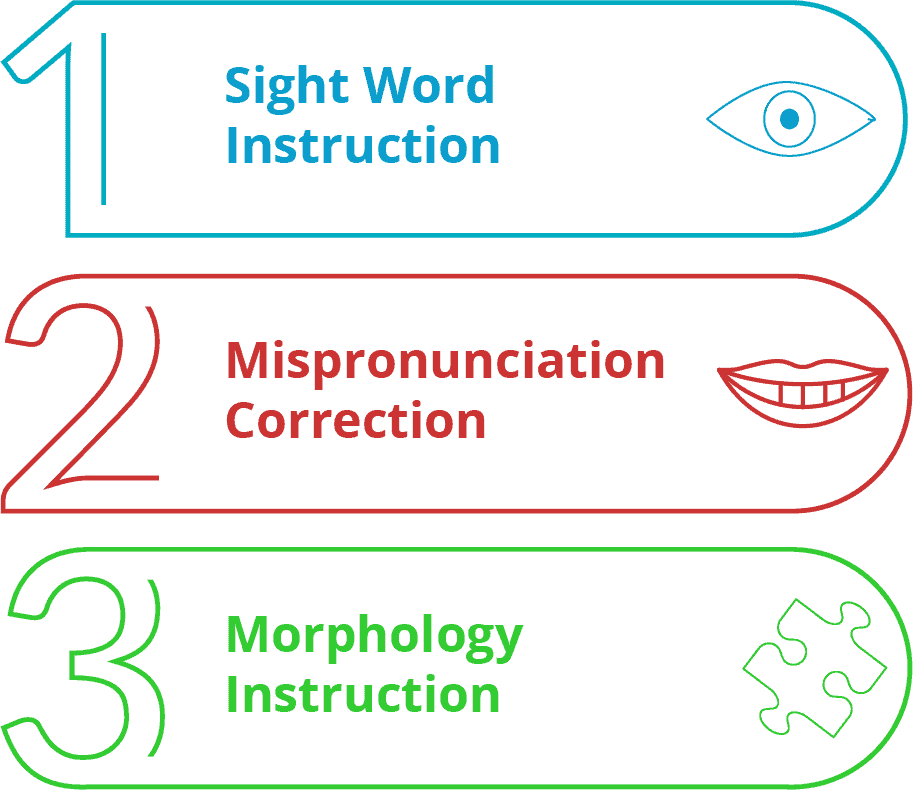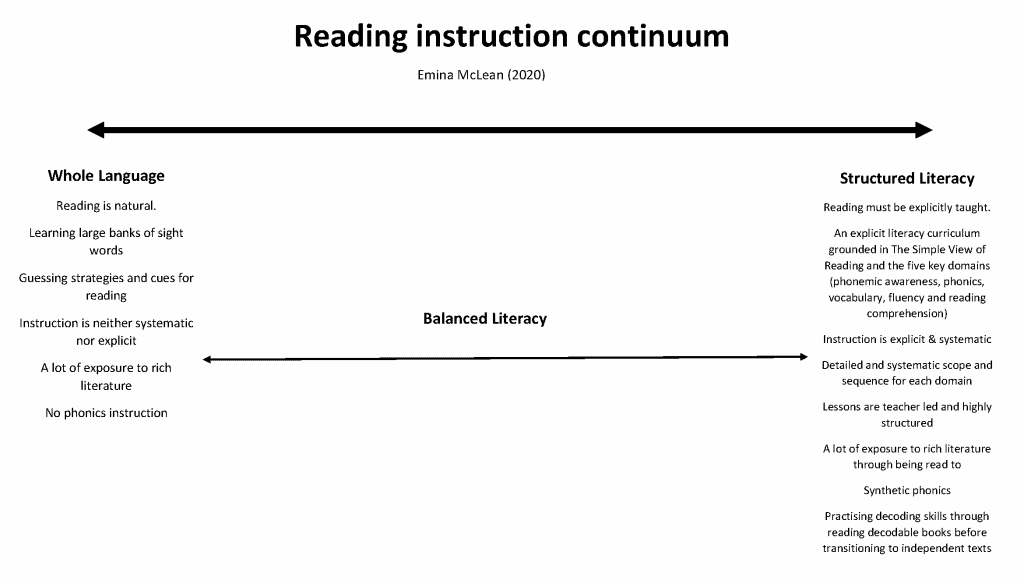Being able to read is critical to success in later life, while illiteracy is often a pathway to unnecessary hurdles and issues in life. Therefore, teaching children to read is of paramount importance. Unfortunately, many dedicated teachers have been misled by menacing misconceptions about reading instruction.
In this article, you will discover more about 4 such misconceptions. These common misconceptions in reading instruction I outline in this article involve:
Meaning
Context cues
Different types of phonics
Balanced literacy
Meaning in Reading Instruction
The Misconception
Reading is a meaning-based activity so that is where reading instruction should start.
The question I ask to counter this is, how do you get to the meaning of a written word if you can’t decode it?
The Correct Conception
Young students know the meaning of most words. They don’t, however, understand how such words are coded in written form. To understand the meaning of written words, teaching should start by helping students decode words.
Once we move from speaking and listening to reading written words in the early years of school, children need to learn the code. Then, they can decode words and access the oral vocabulary that they already mostly know. It is just that children are accessing it via the new medium or print, rather than the medium of speech which they have become familiar with over time.
An Example Experiment – Reading Instruction
The best way to illustrate this is to make up a new code using non-alphabetic symbols. Write a simple sentence containing common vocabulary and ask the audience to read the sentence. They will not be able to decode the words as the code is unknown to them, and they will not be able to tell you what the words mean either.
But what part of this task is unknown to them? It is not the meaning. The words are common words. They know them. They just do not know yet that they know them, right? The unknown part is the code, which will give them access to the meaning of the words that are already in their vocabulary.
So, what do we do next in this experiment? We tell them the sounds each symbol represents. There are adult reading studies that have done just this. Now they can decode the words. with some conscious effort of course, given this code is new knowledge. Yet, but just like that, they are reading for meaning without any focus at all on meaning. You don’t have to teach meaning. Rather, you need to teach access to meaning.
Decoding Gives Children Access to Meaning
In the early years, most children already know the meaning of most words they come across. Such words are part of the children’s oral vocabulary.
Read-alouds in the early years are different in that they often contain more interesting and rare words because they are usually beyond the reading capacity of the student. I am talking about books they are reading themselves. What they need to learn is how to access the meaning in written form, and we teach them how to do this via teaching them phonics, or the alphabetic code, or how speech maps to print.
It is, of course, different for older children. They are reading and learning new and complex words that are not that common in our everyday spoken language. But again, that is still about them being able to decode those words first, and then we can focus on meaning after that, through our direct and indirect vocabulary instruction.
The Simple View of Reading
The misconception that because reading is a meaning based activity, that is where we need to start our reading instruction, ignores the Simple View of Reading equation:

This misconception disregards how word reading develops. We must have regard for the steps involved to get us to the final product.
Sometimes, when people promote this misconception, they are arguing for the Simple View of Reading in some form of reverse sequence. That is, let us focus on meaning (Reading Comprehension), and work our way backward to figure out why it is read that way.
Context Cues in Reading Instruction
There is no reason to look away from the word if our word-level reading instruction and in turn their word-level reading skill is sound.
The Misconception
During reading instruction, you should encourage children should look for cues from pictures and surrounding text when they encounter an unfamiliar word.
The questions I ask to counter this is, why is this an unfamiliar word for this child? What about this word is unfamiliar?
The Correct Conception
Children do not need to look beyond the word if they have adequate decoding and word-level reading skills.
Therefore, the answer involves children knowing how to actually read it. It is usually nothing to do with the meaning of the word, at least in the early years. If they do not know how to decode it, surely the answer is to teach them how to decode it?
We do not need to encourage students to look away from the unfamiliar word given children can:
Decode all unfamiliar decodable words, if we teach the phoneme-grapheme correspondences for the 44 speech sounds from simple through to most complex, incorporating polysyllabic words, morphology and etymology.
Read all unfamiliar non-decodable words if we teach these words using 3 evidence-based methods.
The 3 Evidence-Based Methods

There is no reason to look away from the word if our word-level reading instruction and in turn their word-level reading skill is sound.
The only way students will read words accurately and then store their form for accurate, automatic word reading is through practising decoding all the way through the word, or by learning non-decodable words via sight word learning, mispronunciation correction, and morphology instruction.
96% of Words are Predictable
In 1966, Hanna, Hanna, Hodges and Rudorf published ‘Phoneme-grapheme correspondences as cues to spelling improvement’. Based on an analysis of over 17,000 words, they concluded that:
About 50% of words in English are predictable or regular based on phoneme-grapheme correspondences (PGCs)
A further 34% are predictable except for one irregularity, most commonly a vowel.
Another 12% are quite irregular in terms of English PGCs but they are predictable if you teach your students morphology and etymology.
84% of Words are Predictable through Phonics
Through phonics instruction, we can unlock 84% of words for children.
Through etymology, morphology and essential sight word instruction for truly irregular words, we unlock almost all words for children. Looking away from the word is not reading, it is problem-solving, hypothesising, guessing, whatever you like to call it. No one learns how to complete a task by looking away from it!
I think it is important to note too that at some point in their schooling, children will have to read without picture cues, teacher prompts, and predictable text structures. Where will they be then if they have come to rely upon them?
There is one context within which it is acceptable to look for cues outside of the unfamiliar word, and that is, to hypothesise about what would make sense for meaning after the word has been decoded or read. That is, the word is unfamiliar because they do not know what it means.
We should teach students to look for cues/clues to support comprehension, but not for the actual word reading. This distinction is very important.
Analytic vs Synthetic Phonics
There are 2 ways of teaching phonics.
Analytic
Synthetic
Key Differences
The key differences between analytic phonics and synthetic phonics are usually in how structured and systematic they are. Synthetic phonics is fundamentally structured and systematic, as it follows a defined scope and sequence and has an explicit teaching method. Analytic phonics can vary from structured and systematic to incidental, all the way through to child-directed.
Synthetic phonics starts with phonemes (the smallest subword unit possible) and children learn phoneme-grapheme correspondences in order to be able to decode whole words through blending from part to whole. It is often called the bottom-up approach.
Analytic phonics is concerned with larger parts of words (subword units) like onset-rime and morphemes, and even whole words. Rather than learning to read words by blending from part to whole, the focus is on looking for patterns within words, usually drawing upon prior knowledge, to figure out what the whole word is and why. It is often called the top-down approach.
The Problem
The main problem with analytic phonics is that unless it is structured and systematic (i.e. explicitly teaching onset-rime/word families, and explicitly teaching morphemes), it encourages guessing or hypothesizing, as the primary strategies, and the less structured it is, the less effective it is going to be. All too often it puts a lot of the teaching responsibility on the child.
The Misconception
Analytic and synthetic phonics are equally good.
The question I ask is, what does the research tell us?
The Correct Conception
Systematic phonics wins hands down. Synthetic phonics is likely to be more systematic than analytical phonics. Analytic phonics has a role to play, but this role is likely not paramount until we lay a firm foundation using a synthetic approach.
National Reading Panel Report on Reading Instruction
Let’s start with the National Reading Panel Advice to Teachers Report (2005). Their review of 38 phonics studies found that systematic phonics instruction was best. Systematic phonics instruction means that an explicit phonics curriculum is required, and teachers should be following an explicit scope and sequence rather than trying to teach phonics skills either as students appear to need them (incidental phonics) or by letting students discover the PGCs for themselves.
They found that students who were taught synthetically did somewhat better on various reading measures than students who were taught analytically, that is, they seemed to demonstrate greater learning from a simpler (smallest subword unit) approach. Synthetic phonics instruction was found to be more effective than analytic phonics instruction as evidenced by a greater effect size, but this difference was not statistically significant. If there were more studies at that time, perhaps it would have been. Based on the NRP findings, it was not a matter of one being better than the other. If synthetic and analytic phonics were taught systematically, they were equally good.
A More Recent Review of Synthetic Phonics
For a more recent review of the literature, I recommend reading Jennifer Buckingham’s Systematic phonics instruction belongs in evidence-based reading programs.

A balanced literacy approach is a way of teaching or pedagogy that includes a “philosophical orientation which assumes that reading and writing achievement are developed through instruction and support through multiple environments in which teachers use various approaches that differ by level of teacher support and student control”
Bruce Frey et al. p. 272
One Study
One of the papers referenced in this review by Buckingham (2020) was a randomised control trial which had two components. Study 1 focused on comparing word-level reading, reading comprehension and spelling skills of students taught by analytic or synthetic phonics approaches and Study 2 focused on comparing regular and irregular word reading in both approaches.

The group taught by synthetic phonics had better word reading, spelling, and reading comprehension.
Rhona Johnston et al. p. 1365

It was found in Study 1 that, after 6 years at school, children taught by the synthetic phonics approach read words, spelt words and had reading comprehension skills significantly in advance of those taught by the analytic phonics method.
Rhona Johnston et al. p. 1378

This present study makes an important contribution to documenting the long-term effects of synthetic phonics teaching. Maintaining the gain in word reading for age would have been noteworthy, but in fact, it increased over time, leading to a high level of attainment at the age of 10. This study has confirmed that the synthetic phonics approach is effective in English, even though it is an opaque orthography …
Rhona Johnston et al. p. 1382
My View
My experience in Australia of analytic phonics is that it is almost never systematic, while synthetic phonics almost always is.
I agree with Timothy Shanahan, author of the National Reading Panel Advice to Teachers Report, who has written on his blog about his views on the importance of an analytic approach becoming part of a synthetic phonics approach as soon as possible. That is, at some point, students need to start analysing patterns and morphemes, especially for spelling, but we need to lay the right foundation first.
In the early years, we must ensure our phonics instruction is systematic, following an explicit scope and sequence, with daily instruction, practice and review.
Balanced Literacy
There are 2 defined approaches to teaching children to read. These are:
Whole language
Structured literacy
The Misconception
Reading instruction using a balanced literacy approach is a reasonable compromise between whole Language and structured literacy.
The question I ask to counter this is, what is balanced literacy?
The Correct Conception
The gap between whole language and structured literacy is so wide that the notion of balanced literacy is not well defined. Therefore, it can mean different things in different schools or classes. This makes it impossible to gauge its effectiveness, and hence it is not a reasonable compromise.
Structured Literacy, Balanced Literacy and Whole Language are all ways to approach word-level reading instruction, but they are also ways to approach literacy more broadly (linguistic comprehension and reading comprehension aspects of reading, as well as spelling and writing).
The Reading Instruction Continuum
In my view, there is an instructional continuum. On the far left of the continuum we have Whole Language, with key tenets like reading is natural, exposure to rich texts and being read to a lot is sufficient, and no phonics instruction is required. Nothing is structured or systematic in the instruction, and it involves ad hoc teaching of banks of sight words. On the far right of the continuum is Structured Literacy in which we teach the five keys to reading (phonemic awareness, phonics, fluency, vocabulary and reading comprehension) explicitly, following a scope and sequence for each aspect.

The Chasm that is Balanced Literacy
Balanced Literacy incorporates everything and anything in between those two approaches. I do not really mind Balanced Literacy that sits quite close to Structured Literacy on the continuum. It works pretty well! I like Balanced Literacy less and less the closer it moves toward Whole Language.
It is the incapacity to define it and make it a uniform approach that is its biggest problem. I think there is a misunderstanding about just how explicit and systematic we need to be, to be effective educators in literacy, in order to teach all children to read and write well and leave no one behind.
Here are some key quotes that illustrate its nebulous nature:

It is where literacy is taught using a balance of teacher- and student-initiated activities (Spegiel, 1994), as well as equal attention to phonics skills and whole-language approaches (Goodman, 1992). Finally, a balanced literacy approach is described as using explicit instruction while engaging students in authentic learning experiences, making sure to incorporate equally both reading and writing activities (Tompkins, 2017)
Angeli Wilson & Lori Falcon p. 74
Balanced Literacy is not a reasonable compromise. You cannot assess the effectiveness of an approach if it means different things to different people. Therefore, unless you do not care about effectiveness, you cannot regard balanced literacy as a reasonable compromise.
Here are two continua I use in conversations with schools and I have written about their use in a recent blogpost.
Reading Instruction in a Nutshell
Many misconceptions prevail about reading instruction, and literacy instruction more broadly. To improve the reading and writing skills of children and young people, we can and must do better in disseminating and incorporating best practices.
Professor Pamela Snow and I recently recorded a webinar in which we discussed these common misconceptions along with some others. To view this recording, please visit Pam’s blog.
Thank you to Shaun for the opportunity to write for his excellent website!


Great article! Thank you!
Thanks Natalie
Emina and her colleagues do a lot of work in this area. You can check out more of her work in the above links
Cheers
Shaun
Thank you for a beautifully written article that explains the differences in approach in a simple and well presented way. Much appreciated.
Our pleasure Catherine. I will pass your comment onto Emina.
Thank you Emina and Shaun; Such a clear and helpful article. Should be read by all professionals teaching reading